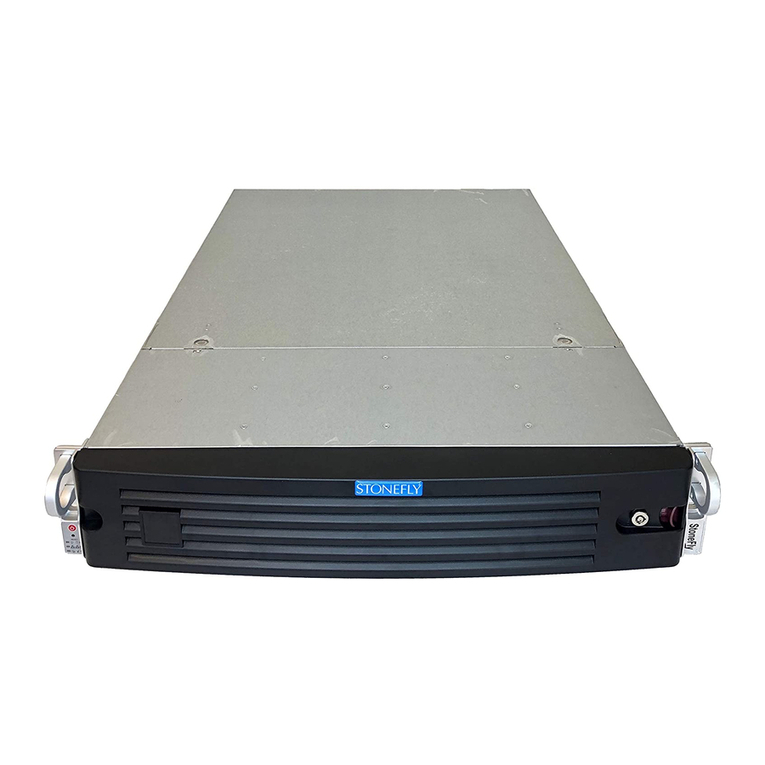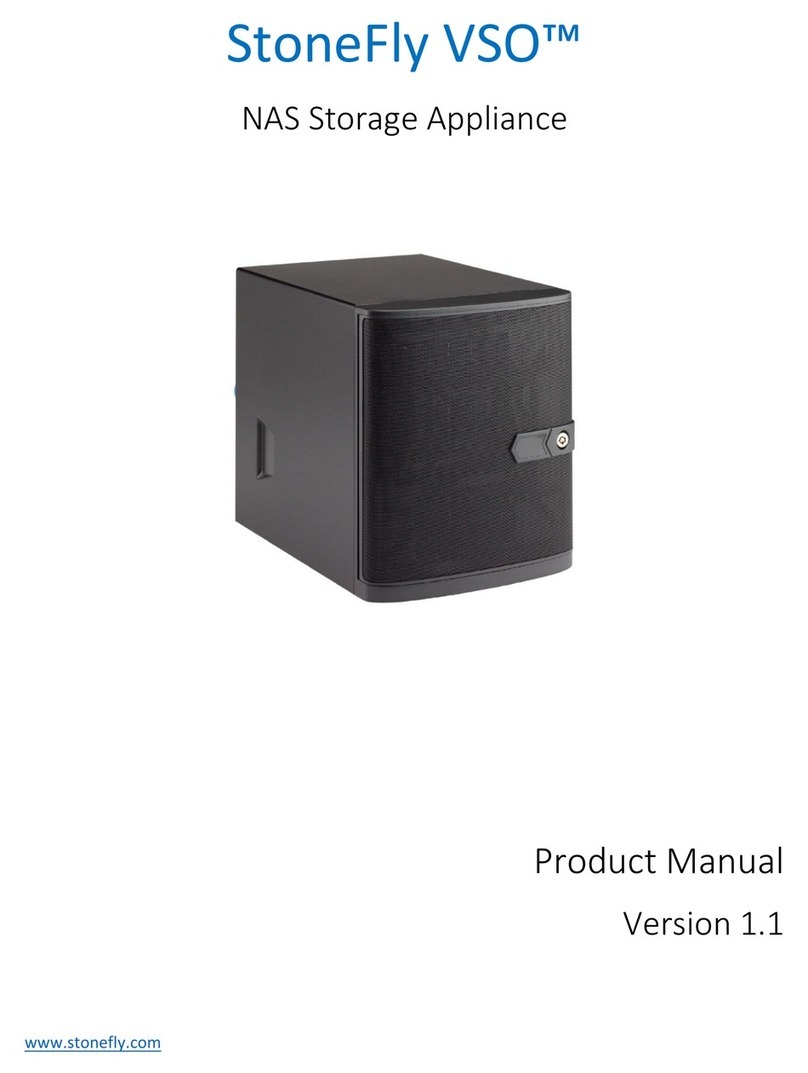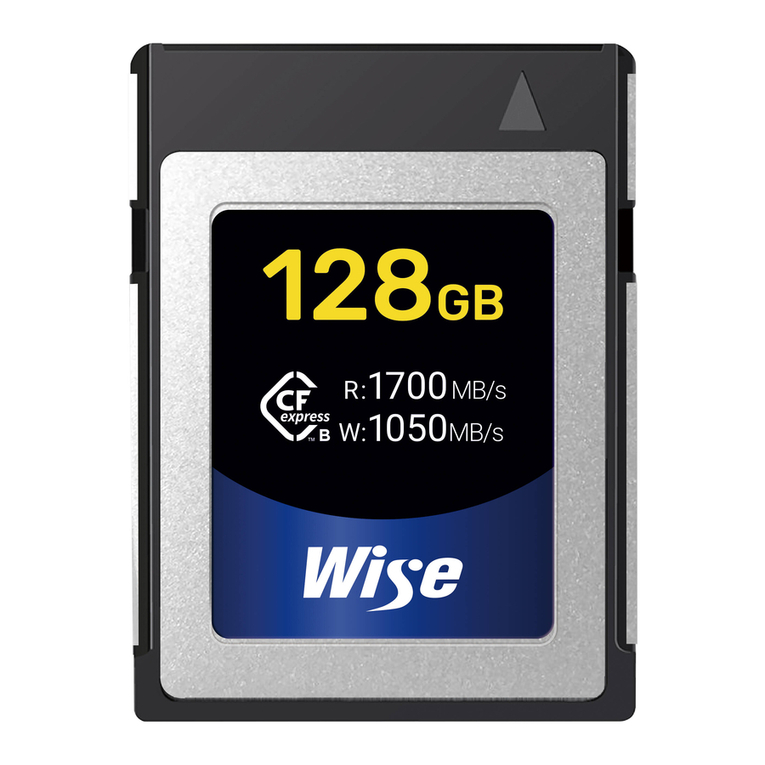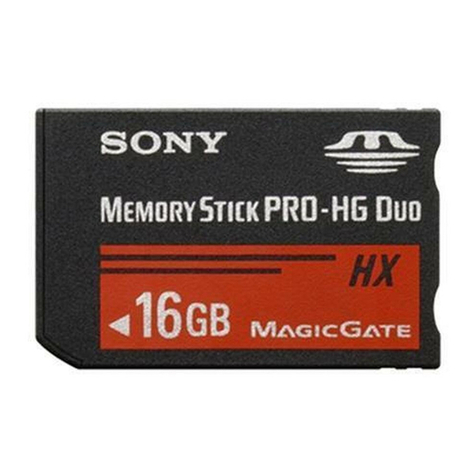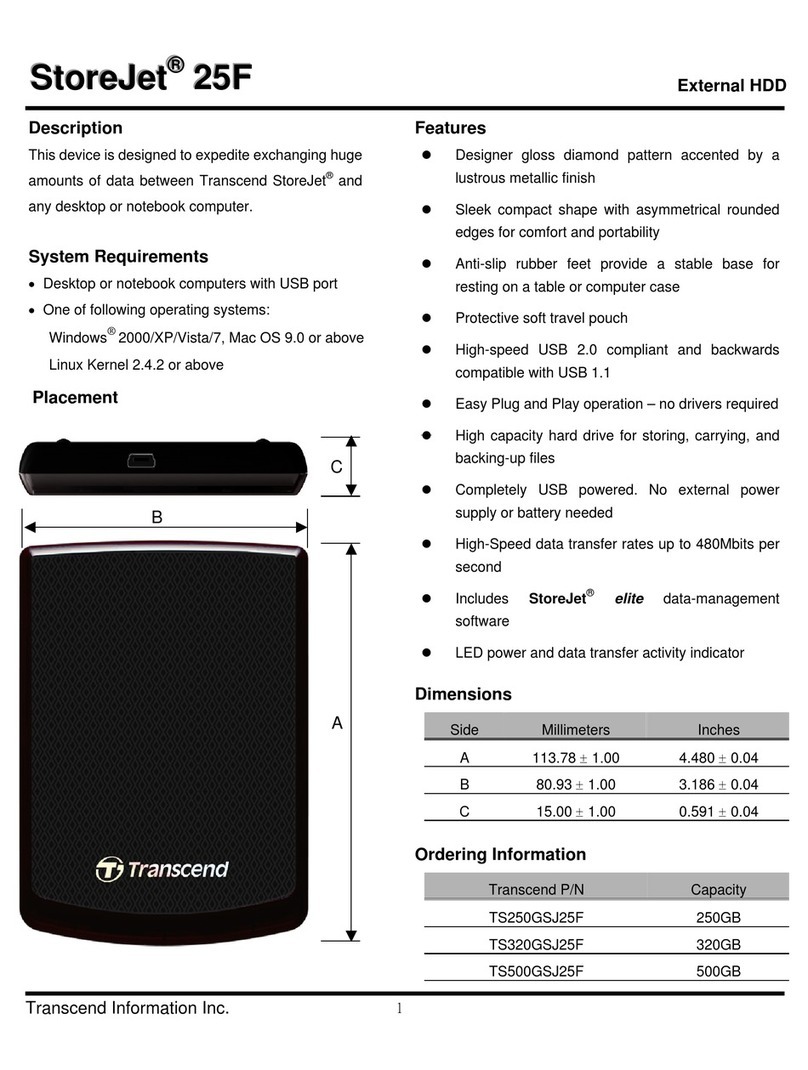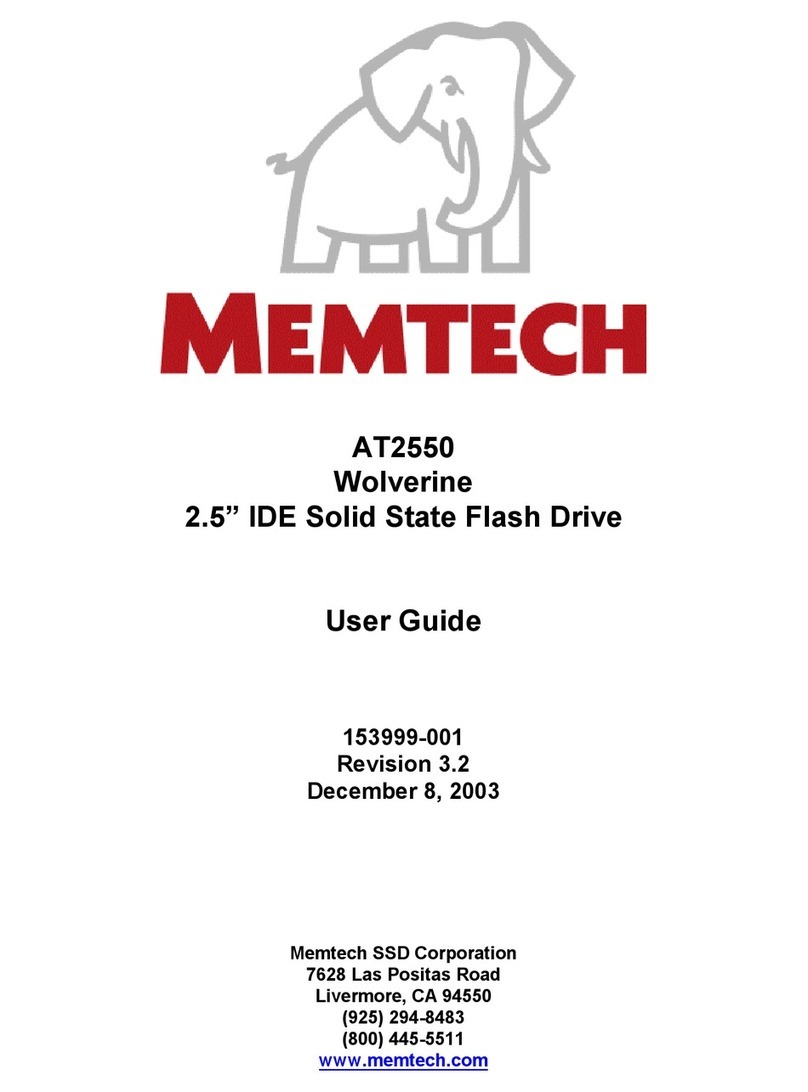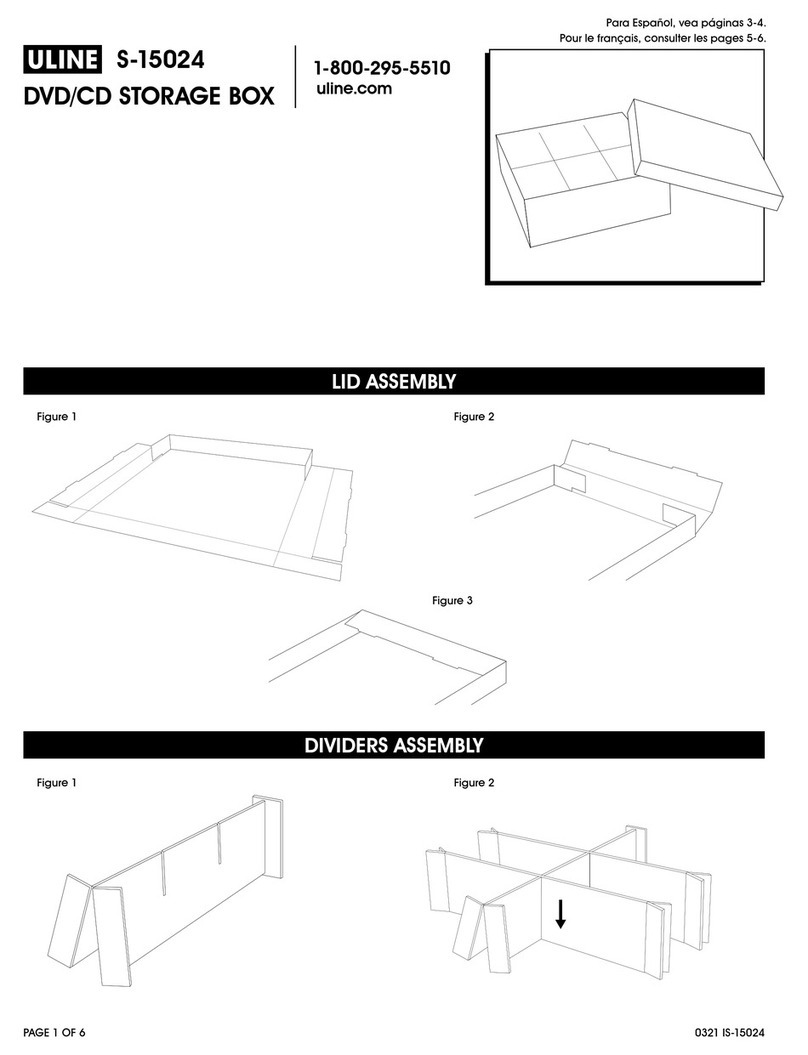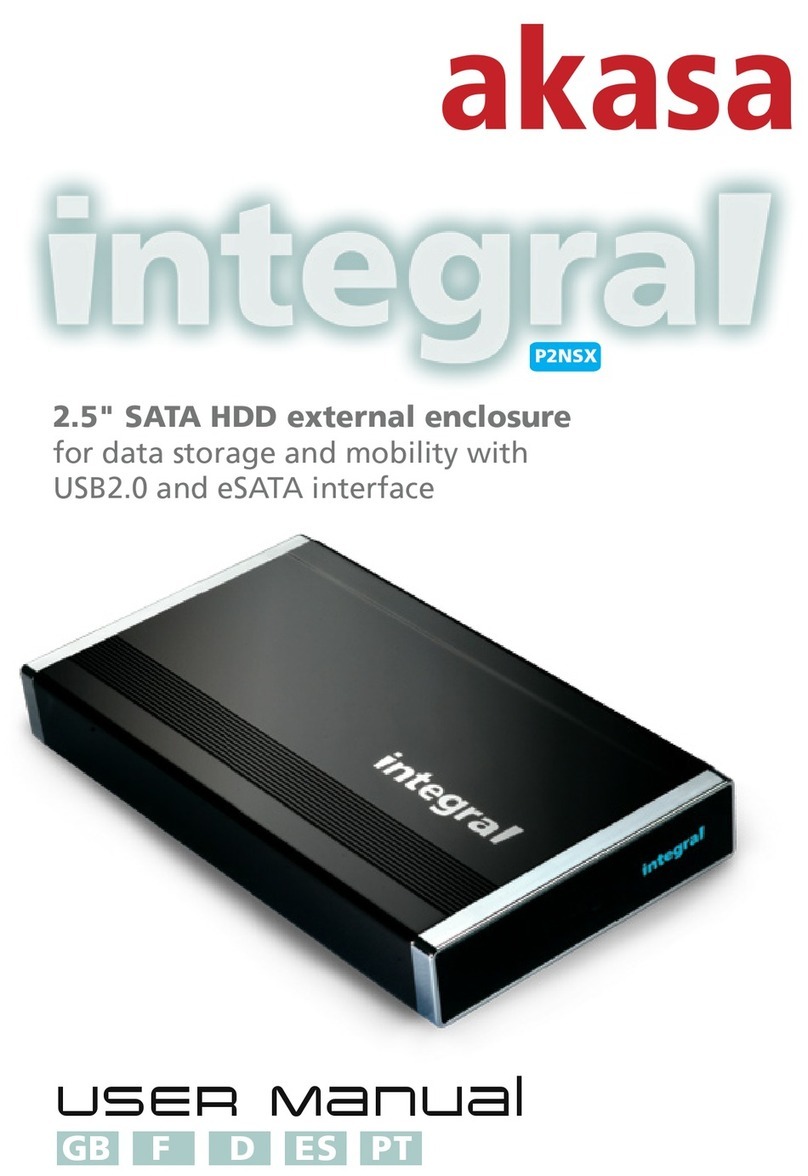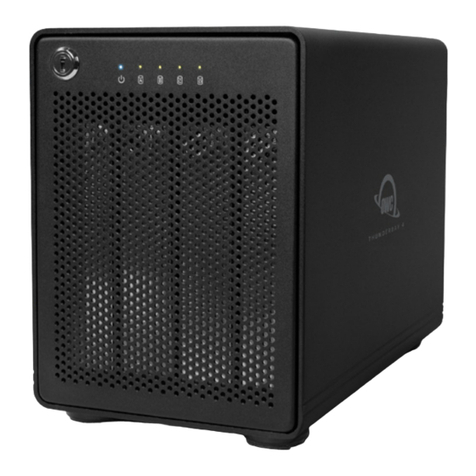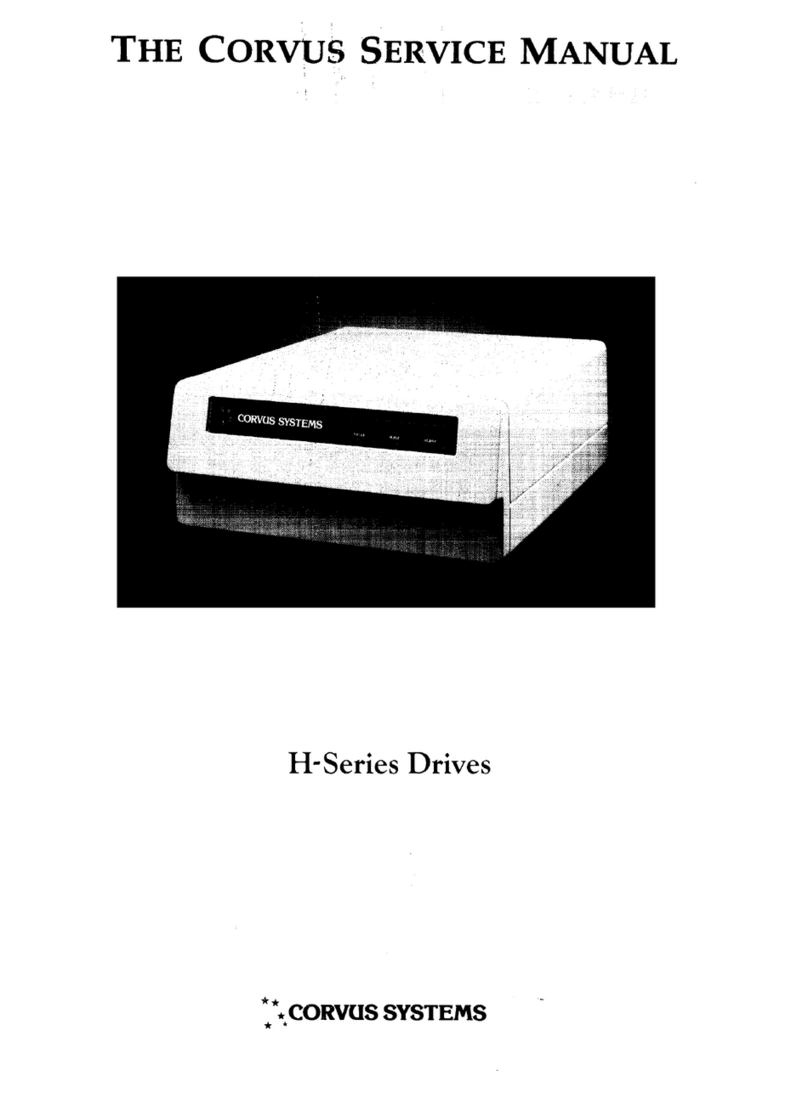STONEFLY USO User manual

Setup Guide
USO - Unified Scale Out Storage
Appliance
www.stonefly.com
www.iscsi.com
USO 24-bay 3.5” 4U Rackmount

This page is intentionally left blank.

Copyright © 2006 – 2020 StoneFly, Inc.
All rights are reserved. No part of this document may be photocopied or reproduced without the prior
written consent of StoneFly.
The information contained in this document is subject to change without notice. StoneFly shall not
be liable for errors contained herein or for consequential damages in connection with the furnishing,
performance, or use of this material.
StoneFly, the StoneFly logo, Storage Concentrator, Integrated Storage Concentrator, ISC, Modular
Storage Concentrator, StoneFly Backup Advantage, StoneFusion, StoneFly Replicator CDP,
ValueSAN, Unified Scale Out, USO, Super Scale Out, SSO, Twin Scale Out, TSO, Unified Storage
& Server, USS, Unified Deduplicated Storage, UDS, Unified Encrypted Storage, UES, OptiSAN,
StoneFly Voyager, DR365, DR365 Fusion, StoneFly Mirroring, Storage Concentrator Virtual
Machine, SCVM, Software-Defined Unified Storage, SDUS, and StoneFly Cloud Drive are
property of StoneFly, Inc.
Other brands and their products are trademarks or registered trademarks of their respective
holders.
Last update 04/2020.

This page is intentionally left blank.

StoneFly USO Appliance Setup Guide
V8.0.3.x
© StoneFly, Inc. 2019
Page 1
TABLE OF CONTENTS
CHAPTER 1 - INTRODUCTION....................................................................................................................... 2
1.1
INTRODUCTION ..................................................................................................................................................................... 3
1.1.1
Other Resources ............................................................................................................................... 3
1.2
CONVENTIONS.......................................................................................................................................................................4
1.2.1
Icons ................................................................................................................................................. 4
CHAPTER 2 - OVERVIEW ............................................................................................................................... 5
2.1
PRODUCT OVERVIEW.......................................................................................................................................................... 6
2.1.1
USO Features and Benefits .............................................................................................................. 8
2.2
THEORY OF OPERATION.....................................................................................................................................................9
2.2.1
iSCSI Overview................................................................................................................................. 9
2.2.2
IP SAN Configuration Overview ...................................................................................................... 9
2.2.3
Network Attached Storage (NAS) ..................................................................................................... 9
2.2.4
iSCSI Host Initiators ...................................................................................................................... 10
2.2.5
Expansion Storage.......................................................................................................................... 10
2.3
INSTALLATION REQUIREMENTS ................................................................................................................................... 10
2.4
SAFETY INFORMATION .................................................................................................................................................... 11
2.4.1
Environmental ................................................................................................................................ 11
2.4.2
Compliance..................................................................................................................................... 11
2.5
PRODUCT REGISTRATION ............................................................................................................................................... 11
2.6
CONTACTING STONEFLY FOR HELP ............................................................................................................................ 12
CHAPTER 3 - INITIAL INSTALLATION ..................................................................................................... 13
3.1
SETTING UP THE USO ............................................................................................................................ 14
3.1.1
Unpacking ...................................................................................................................................... 14
3.1.2
Mounting Equipment ...................................................................................................................... 15
3.1.3
Cabling the System ......................................................................................................................... 20
3.1.4
Powering On & Off Procedure……………………………………………………………………………22
3.1.5
Configuring the Network Settings for the IPMI KVM ....................................................................22
3.1.6
Configuring the Network Settings for the USO’s Management Port..............................................28
3.1.7
Initial Configuration of the StoneFly USO Appliance.................................................................... 30
3.1.8
Setting up Routing .......................................................................................................................... 36
3.1.9
Confirming Setup............................................................................................................................ 37
3.1.10
Steps to Complete Before Setting Up the System: .......................................................................... 38
3.1.11
Attaching and Removing the Front Bezel ....................................................................................... 38
3.1.12
Finalizing the Setup........................................................................................................................ 38
CHAPTER 4 - TROUBLESHOOTING .......................................................................................................... 39
APPENDIX 1 - GLOSSARY ............................................................................................................................ 42

StoneFly USO Appliance Setup Guide
V8.0.3.x
© StoneFly, Inc. 2019
Page 2
Introduction
Chapter-1: Introduction

StoneFly USO Appliance Setup Guide
V8.0.3.x
© StoneFly, Inc. 2019
Page 3
Introduction
1.1
Introduction
This guide provides the information needed to perform the out-of-the-box setup and
configuration tasks for the StoneFly USO™ “Unified Scale Out” storage appliance.
After completing the steps in this guide, proceed to the StoneFly Storage Concentrator User’s
Guide. Refer to “Chapter 2 – Administrative Interface” for information on how to efficiently
and effectively manage data storage, data protection, and data delivery on your network.
This setup guide is intended to be used by network administrators and assumes a basic
understanding of:
Local Area Networks (LAN)
Ethernet and Ethernet-switching concepts
Storage Area Networking (SAN)
1.1.1
Other Resources
Other useful information regarding the setup and use of your USO can be found in the
following places:
StoneFly Storage Concentrator User’s Guide
The StoneFly Web site: http://www.stonefly.com
The USO Online Help in the administrative interface (following initial setup)

V8.0.3.x
© StoneFly, Inc. 2019
Page 4
StoneFly USO Appliance Setup Guide
Introduction
1.2 Conventions
The table that follows lists the conventions used throughout this Setup Guide.
1.2.1
Icons
Icon
Type
Description
Note
Special instructions or information
Warning
Risk of system damage or a loss of data

V8.0.3.x
© StoneFly, Inc. 2019
Page 5
StoneFly USO Appliance Setup Guide
Overview
Chapter-2: Overview

V8.0.3.x
© StoneFly, Inc. 2019
Page 6
StoneFly USO Appliance Setup Guide
Overview
2.1
Product Overview
Based on the StoneFusion operating system, the USO delivers iSCSI target volumes to hosts over
TCP connections in an Ethernet network and offers Network Attached Storage (NAS) volumes
which allow multiple hosts/users to share files. The NAS can be configured in a Scale Out across
multiple nodes. Please refer to Chapter 10 in the User’s Guide to learn about creating a Scale Out
configuration.
Configuring and managing USO is accomplished using a browser-based graphical user interface
(GUI) resident in the USO. Storage resources are connected to the USO through either internal
drives or coming from one or more expansion units connected to the external 12Gb SAS port
(12, 16, 24, and 36-bay USO appliances only). The system administrator uses the GUI to allocate
blocks of storage to create the iSCSI target volumes and authorizes their use by individual host
systems and/or to create NAS segments and volumes.
USO 24-Bay Model (without bezel)
The USO comes in six standard configurations:
•8-bay 2U model features a maximum of 8 x 3.5” SAS drives or SSDs
•12-bay 2U model features a maximum of 12 x 3.5” SAS drives or SSDs
•16-bay 3U model features a maximum of 16 x 3.5” SAS drives or SSDs
•24-bay 2U model features a maximum of 24 x 2.5” SAS drives or SSDs
•24-bay 4U model features a maximum of 24 x 3.5” SAS drives or SSDs
•36-bay 4U model features a maximum of 36 x 3.5” SAS drives or SSDs
The USO comes pre-configured with the RAID configuration you specified during the
ordering process. To change the RAID configuration settings you must use the RAID
configuration utility for the USO. Please consult the RAID Controller Manual.

V8.0.3.x
© StoneFly, Inc. 2019
Page 7
StoneFly USO Appliance Setup Guide
Overview
The USO features a management port, IPMI port, SAS expansion port (12-bay and larger), and
two or more 10Gb network connections (number and type of network connections matching
what you specified during the ordering process). Select models include optional FC SAN
Target ports if the FC SAN Target package was ordered.
Your system also includes (one) EBOD 24 bay expansion unit.
EBOD 24-Bay Model (without bezel)

V8.0.3.x
© StoneFly, Inc. 2019
Page 8
StoneFly USO Appliance Setup Guide
Overview
2.1.1
USO Features and Benefits
The following table details additional features of the USO.
Feature
Benefits
IP network-based SAN intelligence
based on StoneFusion OS
Less expensive to install and operate
Universal connectivity on IP networks
Uses existing network
No retraining of personnel on new
technologies
Lowers total cost of ownership
No distance limitations for IP networks
Storage Provisioning
Add, delete, or expand volumes easily
Maximizes utilization of storage resources
Responds to changes quickly
Mirroring
Supports both local and remote, synchronous
and asynchronous mirroring with StoneFly
Reflection™ and StoneFly Replicator® CDP
software
Disk-to-Disk backup
Simultaneous backup streams from multiple
servers for faster, more reliable backups
Nearly instantaneous restores from disk
HTML-based GUI management
Centralized storage management, control and
monitoring of provisioned storage pools
Access and administer changes from a
browser anywhere at anytime
Secure access (https)
Easy and intuitive to use
Security
Access Control Lists designate which storage
resources are accessible to which hosts and
specify read/write, read only, or no access
privileges
CHAP (Challenge Handshake Authentication
Protocol) supports passwords at the host or
volume level
Expandable storage capacity with
additional storage resources
(optional)
Works with SAS JBODs containing SAS drives.
High availability
Access local and remote copies of user
configuration data

V8.0.3.x
© StoneFly, Inc. 2019
Page 9
StoneFly USO Appliance Setup Guide
Overview
2.2
Theory of Operation
The StoneFly USO™ is the mediator between hosts and storage devices in an IP network. IP-
based Storage Area Networks (IP SANs) use the iSCSI protocol over an Ethernet and TCP/IP
network. USO also offers Network Attached Storage (NAS) which allows multiple host/users
share files over an Ethernet network. Each server, host, or user that needs access to the SAN
storage devices must implement the iSCSI protocol over an Ethernet and TCP/IP network.
2.2.1
iSCSI Overview
iSCSI is a protocol that enables the transmission of block-level data between storage resources
and computers over an IP network. iSCSI combines Ethernet-based IP networking with the SCSI
(small computer systems interface) command set—the core command set used in most storage
configurations. By combining SCSI and IP networking, iSCSI incorporates the two most widely
used storage and networking protocols.
2.2.2
IP SAN Configuration Overview
There are two components which must be considered when setting up the USO:
1.
iSCSI host initiators
2.
Expansion Units (optional)
2.2.3
Network Attached Storage (NAS)
Network Attached Storage (NAS) is a storage technology that allows users to create shared
volumes that can be accessed by one or more users. The difference between iSCSI volumes and
NAS volumes are that NAS volumes (NAS shares) can be accessed by more than one user/server,
but iSCSI volumes in general can only be accessed by one server.
Integrated cloud connection to Microsoft
Azure Blob Storage, Amazon AWS S3 and/or
compatible AWS S3 storage
Object storage resources

StoneFly USO Appliance Setup Guide
V8.0.3.x
© StoneFly, Inc. 2019
Page 10
Overview
2.2.4
iSCSI Host Initiators
An iSCSI host initiator is the component of a server that “initiates” or originates storage
commands. There are three ways to set up iSCSI host initiators to work with the USO:
1.
Using software-based iSCSI initiators on hosts that are connected to the storage
network and “see” logical volumes as disk drives. This configuration requires a
NIC (Network Interface Card) to connect to the 10Gb Ethernet network.
2.
Using an iSCSI adapter that interfaces with the host operating system(OS) in
the same way as a storage Host Bus Adapter (HBA).
3.
Using a TCP Offload Engine (TOE) adapter card to offload the computing-
intensive processing associated with maintaining a TCP/IP connection. A
typical implementation includes both a software and a hardwarecomponent.
2.2.5
Expansion Storage
One of the major benefits of the USO appliance is the ability to expand using optional
expansion units to “scale up” the storage capacity. StoneFly Expansions Units are SAS-
attached JBODs (Just a Bunch of Disks) that house SAS drives. The Expansion Units connect
directly to the 12Gb SAS expansion port on the rear of the USO appliance.
The USO mediates requests from host servers for storage resources, just as servers mediate
storage requests from end-user clients on the network. Therefore, it is prudent to set up the USO
on a dedicated storage network that is operating independently of the LAN that mediates traffic
between clients and hosts.
It is recommended that you setup a dedicated subnet running on a Gigabit network to
prevent management of the USO from interfering with data I/O traffic.
2.3
Installation Requirements
The following minimum network system requirements must be met before attempting to
install the StoneFly USO appliance:
1.
Connectivity to a 10Gb Ethernet network for data.
2.
Connectivity to a Gigabit or better Ethernet network for management.
3.
Storage resources (devices) are either internal drives or coming from expansion
unit(s) connected to an external SAS port.
4.
The Computer must have one of the following browsers:
A.
FireFox 1.0 or later or Netscape 4.7 or later (Windows PC or Linux)
B.
Internet Explorer 5.0 or later (Windows PC only)

V8.0.3.x
© StoneFly, Inc. 2019
Page 11
StoneFly USO Appliance Setup Guide
Overview
2.4 Safety Information
Please review the following safety information completely before installing your USO
appliance.
2.4.1
Environmental
Requirements for power and network availability must be taken into consideration when
planning where to place your USO. The space should have well-regulated temperature and
humidity and should be relatively free of dust and other contaminants. The list below provides
specifics on the environmental requirements:
Operating temperature: +50°F to +95°F (10°C to 35°C)
Altitude: -50 to 10,000 feet (-16 to 3048 meters)
Relative humidity: 8% to 90% (non-condensing)
2.4.2
Compliance
FCC 47 CFR Part 15, Class A
CSA C1088, Class A
UL 60950; CUL 60950
CE Mark (EN 455022, Class A/EN 455024)
2.5 Product Registration
To initiate StoneFly customer service for your product, you must first register your USO
appliance. Go to the StoneFly website at http://www.stonefly.com/support or Mail in the
registration card that was included with your USO appliance or email the information below to
•
Appliance Model Number
•
Appliance Serial Number (begins with D500 and is located on the rear of the chassis)
•
Date of Purchase
•
Company Name
•
Address (including City, State, Zip)
•
Contact Name
•
Phone Number
•
Email Address
•
Dealer’s Name (if purchased from a reseller or distributor)

V8.0.3.x
© StoneFly, Inc. 2019
Page 12
StoneFly USO Appliance Setup Guide
Overview
2.6
Contacting StoneFly for Help
You can reach StoneFly technical support by any of the three following methods:
•
•
Visit https://stonefly.com/support and fill out the contact form.
•
Call 510.265.1616 and select support from the menu.
Please have the following information available when contacting StoneFly technical support for
assistance:
•
Appliance Model Number
•
Appliance Serial Number (begins with D500 and is located on the rear of the chassis)
•
Company Name
•
Contact Name
•
Phone Number
•
Email Address
•
Software Version
•
Initiator Versions (if using iSCSI)
•
Description of the Problem

V8.0.3.x
© StoneFly, Inc. 2019
Page 13
StoneFly USO Appliance Setup Guide
Initial Installation
Chapter-3: Initial Installation

V8.0.3.x
© StoneFly, Inc. 2019
Page 14
StoneFly USO Appliance Setup Guide
Initial Installation
3.1
Setting up the USO
This section will provide step-by-step instructions for initial system configuration and
hardware setup of the StoneFly USO appliance.
3.1.1
Unpacking
Unpack the hardware from the box. You will find:
1.
The StoneFly USO appliance
2.
The front bezel for the USO
3.
The EBOD Expansion Unit
4.
Power cords
5.
A product registration card for the USO
6.
A documentation CD with the StoneFly Storage Concentrator User’s Guide and all
other documentation
7.
A StoneFusion Operating System CD for system recovery
3.1.2
Mounting Equipment
Mounting rails for the USO are included in the package. One set of rails is required for rack mounting
each USO.
4U Rack Installation Instructions
This section provides information on installing a 4U chassis into a rack unit with the rails provided.
There are a variety of rack units on the market, so the assembly procedure may differ slightly. Also refer
to the installation instructions for your rack unit.
Note: This rail will fit a rack between 26.5” and 36.4”.

V8.0.3.x
© StoneFly, Inc. 2019
Page 15
StoneFly USO Appliance Setup Guide
Initial Installation
Identifying the Inner Rack Rails
The chassis package includes one pair of rack rail assemblies in the rack mounting kit. Each assembly
consists of an inner rail that secures to the chassis and an outer rail that is attached directly to the rack.
The inner rails are etched with “L” (Left side) and “R” (Right side).
Identifying the Rack Rails

V8.0.3.x
© StoneFly, Inc. 2019
Page 16
StoneFly USO Appliance Setup Guide
Initial Installation
Installing the Inner Rails on the Chassis
Installing the Inner Rails
Installing the Inner Rails
1.
Identify the left and right side inner rails. Place the correct inner rail on the side of the chassis,
aligning the hooks of the chassis with the inner rail holes. Make sure the rail faces “outward” so
that it will fit with the rack’s mounting bracket.
2.
Slide the rail towards the front of the chassis to hook the inner rail onto the side of the chassis.
3.
If desired, secure the rail with two flat head M4 x 4 mm screws as illustrated.
4.
Repeat for the other inner rail.
Warning: Do not pick up the server by the front handles. They are
designed to pull the system from a rack only.
Table of contents
Other STONEFLY Storage manuals
Popular Storage manuals by other brands
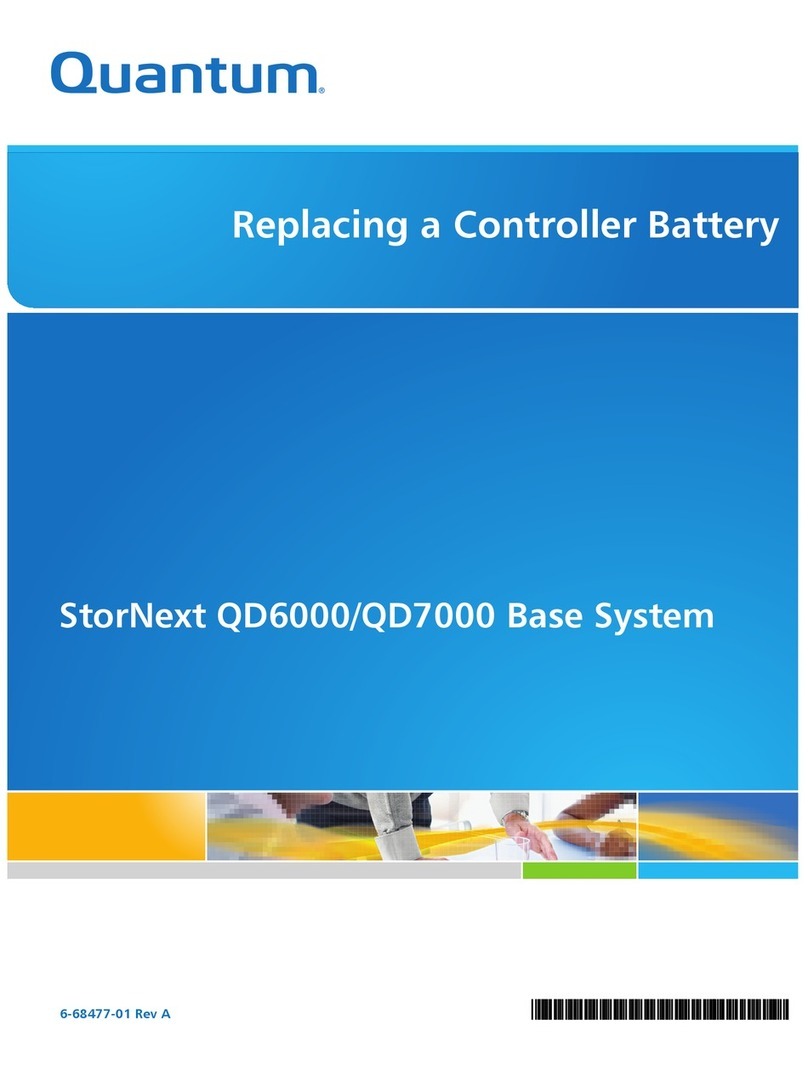
Quantum
Quantum StorNext QD6000 Replacing Guide

Sun Microsystems
Sun Microsystems SunSwift SPARCserver 1000 Service manual

Quantum
Quantum StorNext QM1200 Replacing Guide
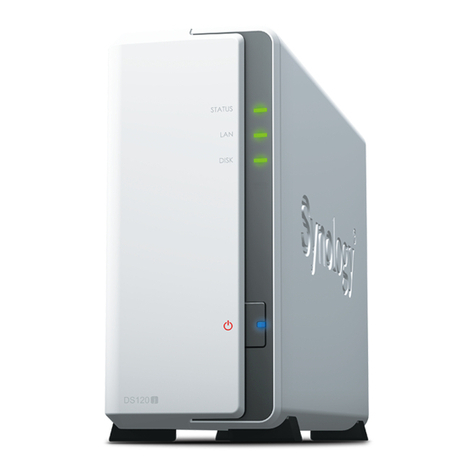
Synology
Synology DS120j Hardware installation guide

HP
HP Surestore Tape Library Model 3/30 Hardware operator's guide
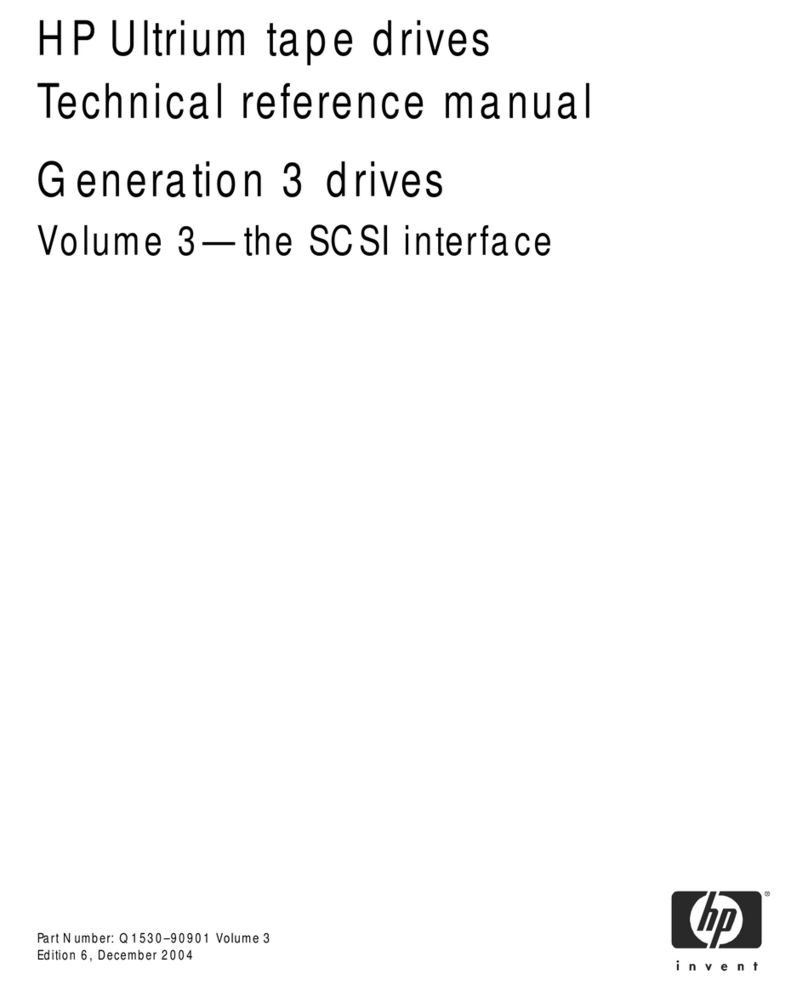
HP
HP Q153090901 Technical reference manual

